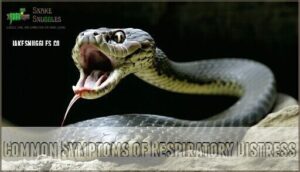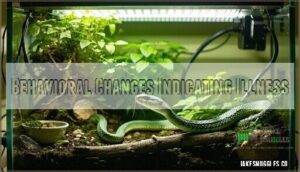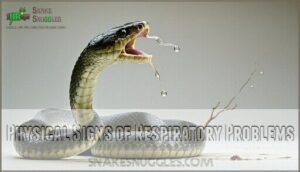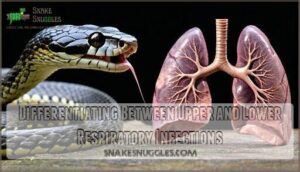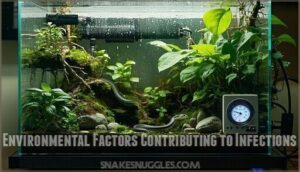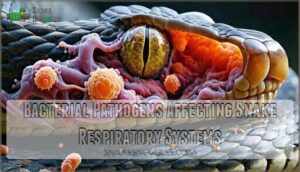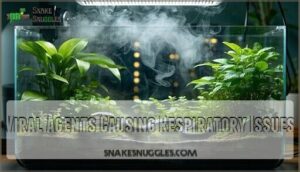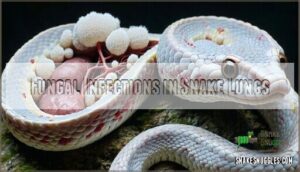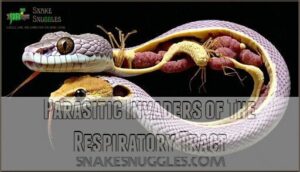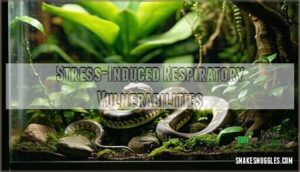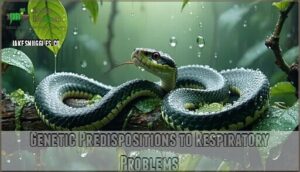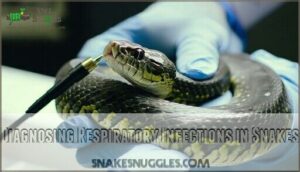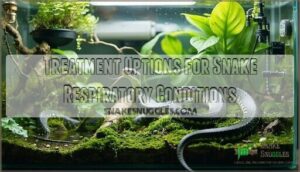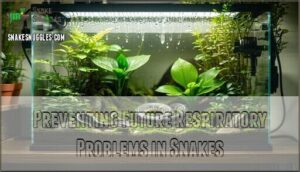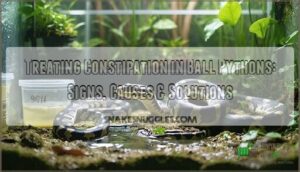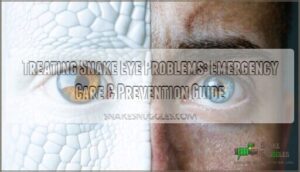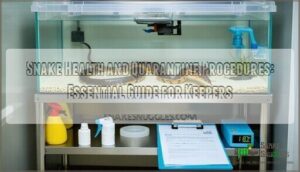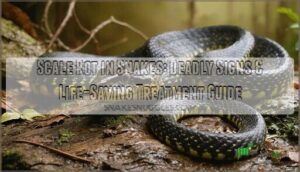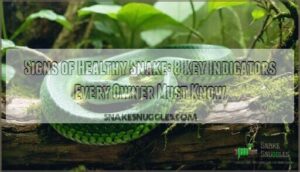This site is supported by our readers. We may earn a commission, at no cost to you, if you purchase through links.
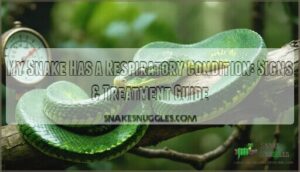 If your snake has a respiratory condition, you’ll notice mouth breathing, wheezing, or excess mucus around the mouth and nose.
If your snake has a respiratory condition, you’ll notice mouth breathing, wheezing, or excess mucus around the mouth and nose.
Your scaly friend might also hold their head up more than usual or show decreased appetite. These infections often stem from poor humidity, temperature swings, or dirty enclosures.
Quick action is vital – respiratory issues can escalate fast in reptiles. A reptile vet will likely prescribe antibiotics and may recommend nebulization treatments.
While waiting for your appointment, maintain proper temperatures and humidity levels. Think of it as your snake’s version of a nasty cold, but one that needs professional attention.
The key lies in catching those subtle early warning signs.
Table Of Contents
- Key Takeaways
- Recognizing Respiratory Infections in Snakes
- Causes of Snake Respiratory Conditions
- Environmental Factors Contributing to Infections
- Bacterial Pathogens Affecting Snake Respiratory Systems
- Viral Agents Causing Respiratory Issues
- Fungal Infections in Snake Lungs
- Parasitic Invaders of The Respiratory Tract
- Stress-Induced Respiratory Vulnerabilities
- Genetic Predispositions to Respiratory Problems
- Diagnosing Respiratory Infections in Snakes
- Treatment Options for Snake Respiratory Conditions
- Antibiotic Therapies for Bacterial Infections
- Antifungal Medications for Fungal Respiratory Issues
- Supportive Care Techniques for Sick Snakes
- Nebulization and Oxygen Therapy Methods
- Nutritional Support During Recovery
- Environmental Modifications to Aid Healing
- Duration and Follow-up of Treatment Protocols
- Preventing Future Respiratory Problems in Snakes
- Frequently Asked Questions (FAQs)
- How to treat a respiratory infection in a snake?
- Will a snake eat if it has a respiratory infection?
- Will a respiratory infection heal itself?
- How to treat a respiratory infection in snakes?
- What does a respiratory infection look like on a snake?
- How much does it cost to treat a respiratory infection in snakes?
- How do I know if my snake has pneumonia?
- What are the chances of my snake recovering fully?
- Can I use human antibiotics for my snakes infection?
- How long does it take for symptoms to show?
- Conclusion
Key Takeaways
- Act quickly when you spot symptoms – Open-mouth breathing, wheezing, nasal discharge, and lethargy signal serious respiratory distress that needs immediate veterinary attention, not home remedies.
- Fix your husbandry immediately – Poor temperature gradients, humidity swings, inadequate ventilation, and dirty enclosures create the perfect storm for respiratory infections in your snake.
- Get proper veterinary treatment – You’ll need antibiotics like enrofloxacin for bacterial infections, plus supportive care, including nebulization therapy and environmental optimization, for full recovery.
- Prevention beats treatment every time – Maintain proper temperature (75-95°F gradient), humidity (40-60%), regular cleaning schedules, and stress-free environments to keep your snake’s respiratory system healthy.
Recognizing Respiratory Infections in Snakes
When your snake shows signs of respiratory distress, quick recognition can make the difference between a treatable condition and a life-threatening emergency.
You’ll need to watch for specific symptoms that signal your pet needs immediate veterinary attention.
Common Symptoms of Respiratory Distress
You’ll notice respiratory distress when your snake can’t breathe normally.
These symptoms signal serious trouble and need immediate attention from an experienced reptile veterinarian.
- Open-mouth breathing – Your snake gasps with mouth wide open, desperately trying to get air
- Nasal discharge – Clear or colored fluid drips from nostrils, often with bubbles
- Wheezing sounds – Audible clicking, gurgling, or whistling noises during breathing
- Labored gasping – Visible effort and struggle with each breath, showing obvious distress
Behavioral Changes Indicating Illness
When respiratory trouble strikes, your snake’s behavior often changes first.
Lethargy signs appear as your pet becomes less active, almost like hitting "airplane mode."
Appetite changes follow – they’ll snub their favorite meal like it’s last week’s leftovers.
Activity decrease means less exploring and more staying put.
Hiding behavior increases as they seek comfort.
Some snakes show aggression spikes when feeling unwell, making handling trickier than usual, and this can be a sign of respiratory trouble, which may lead to lethargy.
Physical Signs of Respiratory Problems
Physical examination reveals telltale signs when your snake struggles to breathe.
Open-mouth breathing signals serious respiratory distress, while nasal discharge and wheezing sounds indicate infection brewing.
- Open-mouth breathing – Your snake’s desperate attempt to get more oxygen
- Nasal discharge – Clear or colored fluid from nostrils suggests inflammation
- Wheezing sounds – Abnormal breathing noises indicate mucus buildup
- Head positioning – Elevated neck stretching helps ease breathing difficulties
Differentiating Between Upper and Lower Respiratory Infections
Understanding the differences between upper and lower respiratory infections helps you respond appropriately to your snake’s breathing problems.
Upper respiratory infections typically present with nasal discharge, slight wheezing, and mild lethargy – think of it as your snake’s version of a head cold.
Lower respiratory infections involve the lungs and show more severe symptoms.
- Lower respiratory infections (snake pneumonia) cause intense open-mouth breathing, gurgling sounds, and significant lethargy, requiring immediate veterinary attention due to their severity levels and potential long-term effects on your pet’s health.
Maintaining proper husbandry, including temperature and humidity, is critical for prevention.
Early Warning Signs to Watch For
Why wait until your snake is gasping for air to take action?
Watch for subtle breathing changes, reduced activity, and appetite changes first.
Early snake respiratory symptoms include slight open-mouth breathing, lethargy, and unusual head posture.
Mucus buildup around the nostrils signals developing snake respiratory infection.
These snake breathing problems indicate snake respiratory distress before severe symptoms appear.
Causes of Snake Respiratory Conditions
Your snake’s respiratory troubles can stem from several culprits, and understanding the root cause is key to getting your scaly friend back to breathing easy.
From environmental mishaps to sneaky bacterial invaders, let’s explore what might be behind your snake’s wheezing woes.
Environmental Factors Contributing to Infections
Your snake’s environment can make or break its respiratory health. Think of it as the difference between a luxury spa and a stuffy basement—one promotes wellness, the other breeds trouble.
Your snake’s home sets the stage for health or disease—choose wisely.
Poor habitat conditions create the perfect storm for respiratory infections:
- Temperature gradients that are too cold weaken your snake’s immune system
- Humidity levels that swing too high or low stress the respiratory tract
- Substrate choices like cedar or pine release irritating oils into the air
- Ventilation importance can’t be overstated—stagnant air harbors pathogens
Environmental factors like improper enclosure temperatures and inadequate humidity control turn your snake’s home into a breeding ground for bacteria and fungi.
Bacterial Pathogens Affecting Snake Respiratory Systems
Several bacterial invaders commonly target your snake’s respiratory system, turning healthy airways into infection hotspots.
Pseudomonas and Aeromonas species lead the charge, while Mycoplasma creates particularly stubborn problems.
These Gram-negative bacteria thrive in compromised snakes:
- Pseudomonas – The most notorious respiratory villain
- Aeromonas – Creates mixed infections that resist treatment
- Mycoplasma – Causes severe pneumonia and tracheitis
Enrofloxacin often tackles these bacterial respiratory infections effectively.
Secondary infections often follow, complicating recovery.
Viral Agents Causing Respiratory Issues
Viruses attack your snake’s respiratory system like uninvited guests crashing the party. Nidovirus infections and Paramyxovirus impact dominate viral respiratory disease in captive snakes, while Adenovirus concerns and Reovirus effects add complexity.
Viral respiratory diseases in snakes are complex, with Viral coinfections worsening symptoms, making treatment challenging since no specific antivirals exist yet. It’s important to note that adenoviruses affect reptiles, potentially leading to fatal hepatic or GI diseases.
| Viral Agent | Primary Symptoms | Transmission Method |
|---|---|---|
| Serpentoviruses (Nidoviruses) | Nasal discharge, oral lesions, labored breathing | Direct contact, respiratory secretions |
| Ferlavirus (Paramyxovirus) | Severe respiratory distress, neurologic signs | Highly contagious via respiratory droplets |
| Orthoreoviruses | Often coinfects with other viruses | Contact with infected animals |
| Arenaviruses | Respiratory symptoms, systemic spread | Direct contact, contaminated environments |
Fungal Infections in Snake Lungs
Fungal lung-invaders like Aspergillus and Penicillium create serious snake respiratory infections through contaminated substrates and poor ventilation.
These opportunistic pathogens exploit stressed or immunocompromised snakes, causing treatment resistance and diagnosis challenges.
Environmental control becomes essential since antifungal medication alone won’t eliminate spore sources.
Snake respiratory fungal infections progress rapidly, making early detection critical for your pet’s survival.
Parasitic Invaders of The Respiratory Tract
Various unwelcome guests can invade your snake’s respiratory system, turning breathing into a struggle.
These parasitic infections create unique treatment challenges that require specialized care from a snake vet experienced in reptile respiratory disease.
- Mite Infestations – These tiny external parasites can block nasal passages and stress your snake’s immune system
- Lungworms – Internal parasites that directly damage lung tissue and cause persistent respiratory symptoms
- Pentastomes – Tongue worms that create severe blockages in the respiratory tract requiring immediate intervention
- Protozoan Infections – Microscopic parasites that inflame airways and complicate other respiratory conditions
- Treatment Challenges – Parasitic respiratory infections often resist standard antibiotics and need targeted antiparasitic medications
Stress-Induced Respiratory Vulnerabilities
When stress hits your snake, it’s like opening the door to respiratory trouble.
Poor handling, cramped quarters, or feeding issues weaken their immune defenses, making infections more likely.
| Stress Source | Impact on Respiratory Health |
|---|---|
| Enclosure Stressors | Cramped spaces limit movement, weakening immunity |
| Handling Stress | Excessive contact triggers defensive responses |
| Shedding Stress | Natural vulnerability period increases infection risk |
Stress reduction through proper snake respiratory environment and gentle care helps maintain strong respiratory defenses against potential threats.
Genetic Predispositions to Respiratory Problems
While stress weakens your snake’s defenses, some reptiles face an uphill battle from birth.
Certain species and bloodlines carry genetic markers that make them more prone to respiratory infections in snakes. Understanding these inherited vulnerabilities helps you provide better care.
Here’s what increases genetic susceptibility:
- Inbred lines – Poor breeding ethics create immune deficiencies
- Species susceptibility – Some breeds naturally struggle with respiratory health
- Genetic markers – Inherited traits that compromise lung function
These snake respiratory genetic predispositions don’t guarantee illness, but they do require extra vigilance on your part.
Diagnosing Respiratory Infections in Snakes
When your snake shows signs of respiratory distress, proper diagnosis becomes essential for effective treatment.
You’ll need a veterinarian experienced with reptiles to perform the necessary tests and examinations that can pinpoint the exact cause of your snake’s breathing problems.
Physical Examination Techniques for Reptiles
A skilled veterinarian’s hands become diagnostic tools during your snake’s physical examination.
Proper handling techniques minimize stress while allowing thorough skin assessment and hydration status evaluation.
The vet will use gentle palpation methods to check for abnormalities and employ auscultation skills to detect abnormal breathing sounds, including signs of open-mouth breathing that signals immediate concern.
This careful examination is part of the veterinary diagnosis process, ensuring a thorough check-up for your snake.
Imaging Methods for Respiratory Assessment
After a thorough physical examination, your veterinarian may recommend advanced imaging methods to get a clearer picture of your snake’s respiratory health.
X-ray analysis remains the gold standard for detecting pneumonia and lung abnormalities in reptiles.
Endoscopic visualization allows direct inspection of airways, while ultrasound imaging can reveal fluid accumulation.
CT scans provide detailed cross-sectional views, and fluoroscopy uses real-time imaging to observe breathing patterns.
These imaging methods enhance veterinary diagnosis accuracy substantially.
Laboratory Tests for Pathogen Identification
When imaging isn’t enough, your vet becomes a lab detective.
Laboratory tests reveal the exact culprit behind your snake’s breathing troubles through precise pathogen identification methods:
- Culture Sensitivity testing grows bacteria to find the right antibiotic
- PCR Testing detects viral infections with lightning speed
- Sample Collection from mouth swabs reveals hidden fungal infections
- Result Interpretation guides your vet’s treatment decisions perfectly
These laboratory tests transform guesswork into targeted treatment.
Bacterial infections, viral infections, and fungal infections each require different approaches—and serology applications help distinguish between them for ideal care.
Endoscopic Procedures for Detailed Inspection
While lab tests identify pathogens, endoscopic procedures offer real-time airway visualization inside your snake’s respiratory system.
This tiny camera allows sample collection from infected areas and precise diagnosis. Modern equipment advances make procedures safer, though procedure risks include anesthesia complications.
Your vet’s veterinary expertise guarantees proper technique, and post-op care involves monitoring recovery closely.
| Procedure Type | Primary Purpose |
|---|---|
| Tracheal Endoscopy | Direct airway examination |
| Bronchoscopy | Lower respiratory assessment |
| Sampling Endoscopy | Tissue/fluid collection |
Think of it as sending a scout into unexplored territory—your snake’s lungs—to map exactly what’s happening inside.
Differential Diagnosis Considerations
When diagnosing snake respiratory disease, your vet weighs multiple factors like a detective solving a puzzle.
Age considerations matter—juveniles show different symptoms than adults. Species variations affect presentation; ball pythons react differently than corn snakes.
Husbandry impact plays a huge role in differential diagnosis. Symptom overlap with mouth rot or parasites complicates things.
Comorbidity factors mean multiple issues might coexist, making veterinary expertise essential for accurate respiratory infections in snakes diagnosis.
Importance of Veterinary Expertise in Diagnosis
Don’t wing it when your snake’s breathing gets sketchy. Professional reptile veterinarians bring specialized knowledge that makes all the difference in accurate diagnosis and treatment guidance.
- Expertise Benefits: Reptile vets distinguish between bacterial, viral, and fungal infections
- Preventing Misdiagnosis: They avoid costly treatment delays from guesswork
- Differential Diagnosis: Professional assessment rules out similar conditions
- Treatment Guidance: Customized protocols based on your snake’s specific needs
Treatment Options for Snake Respiratory Conditions
When your snake shows signs of respiratory distress, quick treatment can make all the difference between recovery and serious complications.
The good news is that most respiratory infections respond well to proper veterinary care, especially when caught early.
Antibiotic Therapies for Bacterial Infections
When your vet confirms bacterial infection, antibiotic therapy becomes your snake’s lifeline.
Enrofloxacin remains the gold standard, administered via injection every 48 hours for maximum absorption. Dosage calculation depends on your snake’s weight—typically 5-10 mg/kg.
Administration routes matter; injectable beats oral for snake respiratory treatment. Watch for side effects like injection site reactions.
Treatment duration spans 2-4 weeks, but antibiotic resistance makes culture testing essential before starting any bacterial infections protocol.
Antifungal Medications for Fungal Respiratory Issues
Your snake’s fungal respiratory condition requires targeted antifungal medications for effective treatment.
Itraconazole and voriconazole show strong azole effectiveness, while amphotericin B tackles severe cases despite nephrotoxicity risks.
Nebulization delivery helps reach infected lung tissue directly, though itraconazole resistance can complicate treatment.
- Oral azoles like itraconazole work well for most fungal infections
- Nebulization delivery targets lung tissue directly when needed
- Amphotericin B reserved for severe cases due to kidney toxicity
- Treatment duration spans 4-12 weeks with careful monitoring required
Supportive Care Techniques for Sick Snakes
When your snake battles respiratory illness, supportive care becomes your secret weapon.
Fluid therapy prevents dehydration while maintaining proper temperature gradient and humidity control creates ideal healing conditions.
Enclosure hygiene reduces bacterial load, and stress reduction through quiet environments accelerates recovery.
Nutritional support with favorite foods keeps energy levels stable during treatment.
Some owners also explore snake nebulization products for targeted relief.
Nutritional support with favorite foods keeps energy levels stable during treatment.
Nebulization and Oxygen Therapy Methods
When supportive care isn’t enough, nebulization and oxygen therapy become your snake’s lifelines.
Nebulizer types include ultrasonic and compressor models—ultrasonic creates finer particles for deeper lung penetration.
Oxygen concentration should stay at 40-60% to avoid toxicity.
Therapy duration runs 15-30 minutes, twice daily.
Medication delivery through nebulization targets infected tissues directly.
Home setup requires veterinary guidance for safety and effectiveness.
Nutritional Support During Recovery
During recovery, your snake’s appetite might disappear completely—and that’s completely normal! You’ll need to be patient but proactive about getting nutrients back into their system.
Here’s how to support your recovering snake:
- Offer favorite prey items at slightly warmer temperatures to entice feeding
- Provide multiple small meals instead of one large feeding session
- Use appetite stimulants like assist-feeding syringes for stubborn eaters
- Monitor hydration methods through soaking dishes and humidity levels
- Consider supplement options like liquid vitamins mixed with water
Weight loss happens quickly during respiratory infections, so don’t wait too long before discussing force feeding techniques with your vet. Sometimes anorexia requires dietary adjustments—switching prey types or sizes can make the difference between recovery and decline.
Environmental Modifications to Aid Healing
Creating the right environment helps your snake bounce back faster from respiratory troubles.
You’ll want to fine-tune their habitat to support healing while keeping them comfortable.
Here are three key environmental modifications to aid healing:
- Humidity adjustments – Increase humidity to 60-70% to help loosen mucus and ease breathing, but make certain proper ventilation strategies prevent stagnant air
- Temperature gradients – Maintain ideal temperature control with a slight increase in the warm side to boost immune function during recovery
- Substrate selection – Switch to paper towels or reptile carpet for easy cleaning and disinfection while eliminating dust that could irritate airways.
Addressing underlying bacterial infections is also vital for recovery.
Duration and Follow-up of Treatment Protocols
Treatment success depends on patience and consistency. Most bacterial infections require 10-14 days of antibiotic duration, but your snake’s recovery phases may extend several weeks.
Watch for relapse monitoring signs like returning symptoms. Resistance development becomes possible with incomplete treatment.
Consider probiotic support during recovery. Long-term effects vary, making regular snake respiratory veterinary care essential for ongoing supportive care.
Preventing Future Respiratory Problems in Snakes
Once you’ve treated your snake’s respiratory condition, you’ll need to create an environment that protects them from future infections.
Think of it like childproofing your home – you’re setting up defenses before problems strike again, which is a key concept in preventing future infections.
Optimal Enclosure Setup for Respiratory Health
Your snake’s enclosure setup directly impacts their respiratory health. Temperature gradients between 75-85°F prevent immune system stress, while proper humidity levels (40-60%) keep airways moist without encouraging bacterial growth.
Choose substrate materials like paper towels or cypress mulch—avoid cedar or pine that irritate lungs.
Adequate snake habitat ventilation is also a must. Make certain adequate ventilation needs with screened tops, and provide enclosure size that allows natural movement patterns.
Proper Temperature and Humidity Control
Perfect climate control keeps your snake’s lungs healthy and happy. Think of it as snake AC maintenance that prevents respiratory nightmares!
- Temperature gradients should span 75-95°F depending on your species
- Humidity monitoring with quality hygrometers prevents dangerous fluctuations
- Enclosure ventilation balances airflow without creating drafts
- Misting systems maintain consistent moisture levels automatically
- Hydrometer placement in cool and warm zones tracks ideal environmental conditions
To bolster their health, consider regular veterinary check-ups.
Regular Cleaning and Disinfection Practices
Beyond temperature and humidity, your cleaning routine makes or breaks snake respiratory prevention. A dirty enclosure breeds pathogens that trigger respiratory distress, so let’s get your disinfection game on point.
| Cleaning Task | Frequency | Method |
|---|---|---|
| Water bowl hygiene | Every 3-4 days | Scrub with 10% bleach solution |
| Substrate sanitation | Weekly spot-clean | Replace soiled areas immediately |
| Quarantine cleaning | After each use | Full disinfectant wipe-down |
Smart disinfectant choices matter – avoid harsh chemicals that irritate airways. You can find a suitable snake enclosure cleaner online.
Your cleaning schedule should include weekly deep-cleans and daily spot-checks for waste or spilled water.
Nutritional Considerations for Immune Support
A balanced diet forms your snake’s first line of defense against respiratory infections.
You can’t just throw any prey item in there and hope for the best! Vitamin supplements, especially vitamin C and A, strengthen immune function when added to feeder animals.
Hydration importance can’t be overstated—dehydrated snakes struggle with gut health and immunity.
Immune-boosting foods include varied prey sizes and species to provide diverse nutrients essential for snake respiratory health.
Stress Reduction Strategies in Captivity
In your snake’s world, chronic stress weakens immunity and increases snake respiratory distress.
Proper snake husbandry includes creating hiding places, using gentle handling methods, and providing enrichment techniques that encourage natural behaviors.
A stress-free snake environment supports ideal snake respiratory care and overall health.
Quarantine Procedures for New Snakes
New arrivals need proper quarantine procedures to protect your existing collection.
Set up a separate enclosure with standard snake health monitoring for isolation duration of 3-6 months.
This snake quarantine prevents snake respiratory issues from spreading while reducing stress through consistent enclosure setup.
Implement daily monitoring protocols and consider preventative medication consultations.
Think of it as your snake’s "getting-to-know-you" period before joining the family.
Routine Health Monitoring and Veterinary Check-ups
Regular inspections keep your snake healthy and catch problems early.
Schedule routine health monitoring visits with a reptile vet every 6-12 months for preventative care.
Keep detailed records of eating, shedding, and behavior patterns.
Finding the right snake vet near me takes research, but it’s worth the investment for your pet’s long-term health and early detection of issues.
Frequently Asked Questions (FAQs)
How to treat a respiratory infection in a snake?
You’ll need veterinary care for proper diagnosis and antibiotics. Meanwhile, optimize your snake’s enclosure temperature and humidity levels. Antibiotics like enrofloxacin treat bacterial infections effectively.
Will a snake eat if it has a respiratory infection?
Like a candle flickering in the wind, your snake’s appetite often dims when respiratory illness strikes.
Most snakes won’t eat during infections—reduced appetite‘s a common symptom.
They need energy to fight the infection first, which is why respiratory illness can have such a significant impact on their behavior.
Will a respiratory infection heal itself?
Snake respiratory infections won’t heal themselves. You’ll need veterinary treatment with antibiotics for bacterial infections, proper husbandry adjustments, and supportive care to help your snake recover fully.
How to treat a respiratory infection in snakes?
You’ll need a veterinary exam for proper diagnosis and antibiotic treatment.
Meanwhile, optimize your enclosure’s temperature and humidity, improve ventilation, and consider nebulization therapy to help clear airways and support recovery.
What does a respiratory infection look like on a snake?
Like a warning bell ringing, your snake’s body will show telltale signs when respiratory trouble strikes. You’ll notice open-mouth breathing, wheezing sounds, nasal discharge, and lethargy replacing normal behavior patterns.
How much does it cost to treat a respiratory infection in snakes?
Treatment costs typically range from $100-$500, depending on severity and testing required.
Initial vet visits cost around $100, but complex cases can reach $400-$
You’ll need antibiotics and possibly X-rays or culture tests.
For severe cases, vets might recommend snake endoscopy costs, which can further increase expenses due to the need for specialized care.
How do I know if my snake has pneumonia?
When your snake’s breathing sounds like a broken accordion, you’ve likely spotted pneumonia. Watch for open-mouth breathing, wheezing sounds, nasal discharge, and lethargy—these red flags demand immediate veterinary attention.
What are the chances of my snake recovering fully?
Your snake’s recovery chances depend on early detection and proper treatment. With prompt veterinary care, appropriate antibiotics, and ideal husbandry conditions, most snakes recover fully from respiratory infections.
Can I use human antibiotics for my snakes infection?
Using human antibiotics for your snake is like trying to fit a square peg in a round hole – it’s dangerous and ineffective.
Never use human medications on reptiles without veterinary guidance, as dosages and formulations differ substantially, potentially causing toxicity or treatment failure.
How long does it take for symptoms to show?
Respiratory symptoms in snakes typically appear within days to weeks after exposure to pathogens or poor environmental conditions.
You’ll notice early signs like subtle lethargy and occasional open-mouth breathing before more obvious symptoms develop, which can include more severe signs that indicate a serious issue.
Conclusion
Remember, respiratory infections are absolutely the worst nightmare for any snake owner, but they’re completely manageable with quick action.
If you suspect my snake has a respiratory condition, don’t wait around hoping it’ll resolve itself.
Contact your reptile vet immediately for proper diagnosis and treatment.
With antibiotics, supportive care, and environmental adjustments, most snakes recover fully.
Prevention through proper husbandry remains your best defense against future respiratory issues.
- https://www.petmd.com/reptile/conditions/mouth/mouth-rot-bearded-dragons
- https://www.reptileknowledge.com/reptile-pedia/how-do-you-treat-a-ball-python-respiratory-infection
- https://menacetopests.com/how-long-do-snakes-live/
- https://pmc.ncbi.nlm.nih.gov/articles/PMC7459564/
- https://www.merckvetmanual.com/exotic-and-laboratory-animals/reptiles/viral-diseases-of-reptiles

